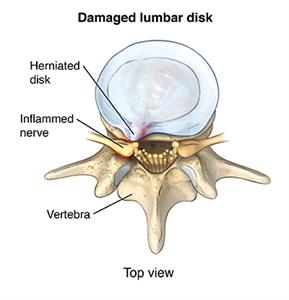Sciatica
What is sciatica?
Sciatica, also called lumbar radiculopathy, is a pain that originates along your sciatic nerve. This extends from the back of your pelvis down the back of your thigh. Your sciatic nerve is the primary nerve of your leg. It is also the largest nerve in your entire body.
What causes sciatica?
Usually, sciatica is caused by a herniated disk in your spine that presses on your sciatic nerve.

Other reasons for pressure on your sciatic nerve may include:
- Obesity
- Poor posture
- Tumor
- Abscess
- Blood clot
- Awkward sitting position
- Any nerve disorders
Sometimes, the cause for your sciatica cannot be identified.
What are the symptoms of sciatica?
Following are the most common symptoms of sciatica. However, you may experience symptoms differently. Symptoms may include:
- Lower back pain that radiates down your buttock and the back of one thigh
- Pain that extends from your buttock down to your foot
- Numbness (in severe cases)
- Weakness (in severe cases)
The symptoms of sciatica may resemble other conditions or medical problems. Always consult your health care provider for a diagnosis.
How is sciatica diagnosed?
In addition to a complete medical history and physical examination, diagnostic procedures for sciatica may include the following:
- X-ray. Invisible electromagnetic energy beams produce images of internal tissues, bones, and organs onto film.
- Magnetic resonance imaging (MRI). A combination of large magnets, radiofrequencies, and a computer produce detailed images of organs and structures within your body.

- Electromyography and nerve conduction study (EMG and NCS). A diagnostic procedure conducted together that records and analyzes electrical impulses in your muscles. During the EMG, thin needles are placed in your muscle to record electrical activity. The NCS is often done along with the EMG to determine if a nerve is functioning normally. Electrodes are then placed in various locations on your skin along the nerve pathway. When stimulating the nerve at various places, your health care provider can then determine the specific site of your injury.
What is the treatment for sciatica?
Your health care provider will determine the specific treatment for sciatica, based on:
- Your age, overall health, and medical history
- Extent of the disease
- Your tolerance for specific medications, procedures, or therapies
- Expectations for the course of the disease
- Your opinion or preference
Sciatica usually heals on its own with rest and time. To help relieve the pain, treatment may include:
- Nonsteroidal anti-inflammatory medications
- Heat or cold applications to the sore muscles
- Movement (keeping your body in motion minimizes inflammation)
- Surgery (to repair your herniated disk, if the condition persists)
What are the complications of sciatica?
Because sciatica is caused by pressure on a nerve in your spine, complications may develop if the pressure is not relieved. Possible complications of unrelieved nerve compression include:
- Increased pain
- A slipped or herniated disc
- Loss of feeling or weakness in your affected leg
- Loss of bowel or bladder function
- Permanent nerve damage
When should I call my health care provider?
Notify your health care provider if:
- Your pain worsens
- You lose feeling in your affected leg, or notice weakness in your leg
- You develop problems with your bowels or bladder
- Your pain returns after successful treatment of your sciatica
Key points
Sciatica most commonly occurs in people between the ages of 30 and 50 years.
- It is pain that originates along your sciatic nerve and radiates down your buttock and the back of one thigh
- It is usually caused by a herniated disk in your spine that presses on your sciatic nerve.
- Sciatica usually heals on its own with rest and time
- Sciatica may resemble other conditions or medical problems. You should always consult a health care provider for a diagnosis.
Next steps
Tips to help you get the most from a visit to your health care provider:
- Before your visit, write down questions you want answered.
- Bring someone with you to help you ask questions and remember what your provider tells you.
- At the visit, write down the names of new medicines, treatments, or tests, and any new instructions your provider gives you.
- If you have a follow-up appointment, write down the date, time, and purpose for that visit.
- Know how you can contact your provider if you have questions.
Online Medical Reviewer: Berry, Judith, PhD, APRN
Online Medical Reviewer: Foster, Sara, RN, MPH
Date Last Reviewed: 1/29/2014
© 2000-2016 The StayWell Company, LLC. 780 Township Line Road, Yardley, PA 19067. All rights reserved. This information is not intended as a substitute for professional medical care. Always follow your healthcare professional's instructions.